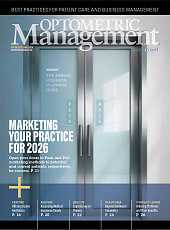Wavefront-guided scleral lenses (wfgSLs) have been demonstrated to effectively reduce residual higher-order aberrations (HOAs) and improve subjective quality of vision in individuals who have corneal ectasia, particularly keratoconus (KC).1 Additionally, wfgSLs have enhanced both visual acuity and contrast sensitivity compared to traditional scleral lenses (SLs), often achieving levels similar to eyes without ectasia.2-5 The extent of improvement depends on lens positional stability and an appropriate habituation period.4-6
Gelles and colleagues published the interim outcomes of a single center, randomized, double- blind, crossover-controlled clinical trial evaluating wfgSLs to traditional SLs for individuals with a history of irregular corneal astigmatism.1 This study assesses the practicality of implementing wfgSLs in clinical practice and was performed in a typical clinical setting.
This study included 18 individuals, accounting for a total of 31 eyes with irregular corneal astigmatism. Corneal conditions were KC (23), post-corneal refractive ectasia (6), and post-penetrating keratoplasty (2). Those eyes that had lens or corneal opacities were excluded from participating in the study. Once the fit was finalized, a comprehensive wavefront aberrometer-based system was applied to measure the residual aberrations of the traditional SLs under scotopic conditions without pharmacologic dilation. These data were then utilized to design the wfgSL. Next, the individual wore lens A (traditional SL or wgfSL) or lens B (the alternative), for a 461-week interval. Visual acuity and total higher-order root mean squared (HORMS) were documented at each interval under precise lighting conditions. At the final visit, patients’ subjective preference for lens A or lens B was documented.
In this study, all eyes demonstrated a decrease of HORMS, ranging from 18% to 83%, with an average improvement of 56% (p < 0.001). WfgSLs improved visual acuity, providing an average enhancement of 0.12 ± 0.11 logMAR (p < 0.01). Seventy-one percent of eyes experienced an improvement of at least one line, 26% showed no change, and 3% exhibited a reduction in visual acuity with the wfgSLs. Seventeen out of 18 patients subjectively preferred wfgSLs.
WfgSLs demonstrated a reduction in HORMS and an improvement in visual acuity compared to traditional SLs. Subjectively, individuals showed a preference for wfgSLs over traditional SLs. This study confirms the clinical feasibility of wavefront-guided technology and supports its applicability across various etiologies of irregular corneal astigmatism.
Additional research is needed to address potential limitations and expand the clinical use indications for wfgSLs. As the study continues and additional data are collected, interim results may evolve into more robust and statistically significant findings.
Reference(s):
1. Gelles JD, Su B, Kelly D, et al. Visual improvement with wavefront-guided scleral lenses for irregular corneal astigmatism. Eye Contact Lens. 2025 Feb 1;51(2):58-64. doi: 10.1097/ICL.0000000000001152.
2. Marsack JD, Ravikumar A, Nguyen C, et al. Wavefront-guided scleral lens correction in keratoconus. OptomVis Sci. 2014;91(10):1221-1230. doi: 10.1097/OPX.0000000000000275
3. Sabesan R, Johns L, Tomashevskaya O, et al. Wavefront-guided scleral lens prosthetic device for keratoconus. Optom Vis Sci. 2013;90(4):314-323.
doi: 10.1097/OPX.0b013e318288d19c
4. Hastings GD, Applegate RA, Nguyen LC, Kauffman MJ, Hemmati RT, Marsack, JD. Comparison of wavefront- guided and best conventional scleral lenses after habituation in eyes with corneal ectasia. Optom Vis Sci. 2019;96(4):238-247. doi: 10.1097/OPX.0000000000001365
5. Hastings GD, Nguyen LC, Kauffman MJ, Hemmati RT, Marsack JD, Applegate RA. Avoiding penetrating keratoplasty in severe keratoconus using a wavefront-guided scleral lens. Clin Exp Optom. 2022;105(1):86-88. doi: 10.1080/08164622.2021.1945407
6. Rijal S, Hastings GD, Nguyen LC, Kauffman MF, Applegate RA, Marsack JD. The impact of misaligned wavefront-guided correction in a scleral lens for the highly aberrated eye. Optom Vis Sci. 2020;97(9):732-740. doi: 10.1097/OPX.0000000000001577
This editorial content was supported via unrestricted sponsorship.




